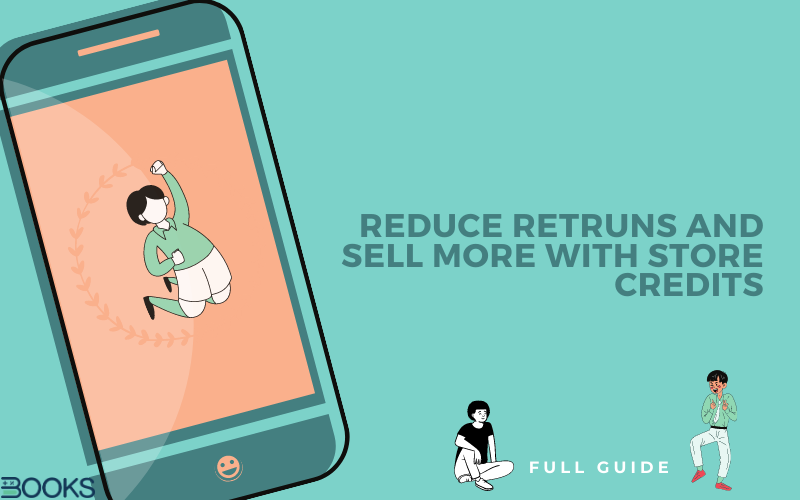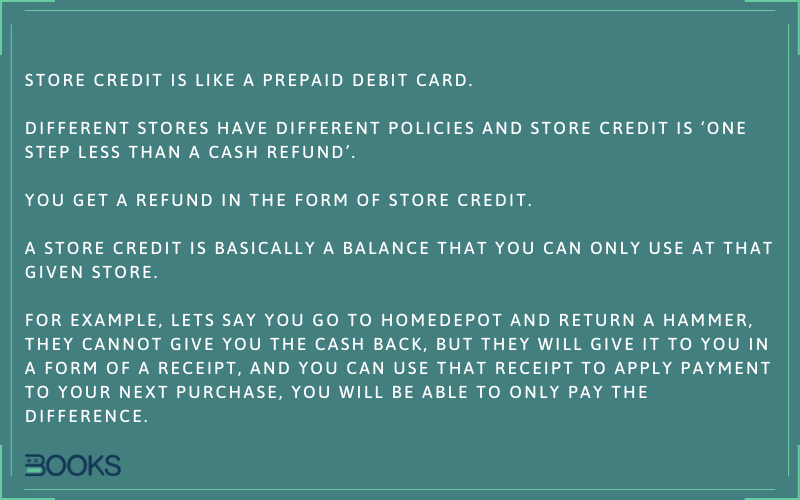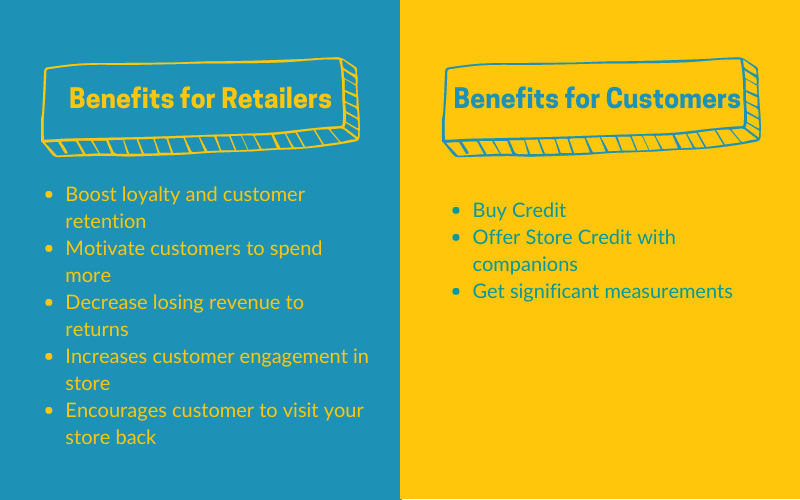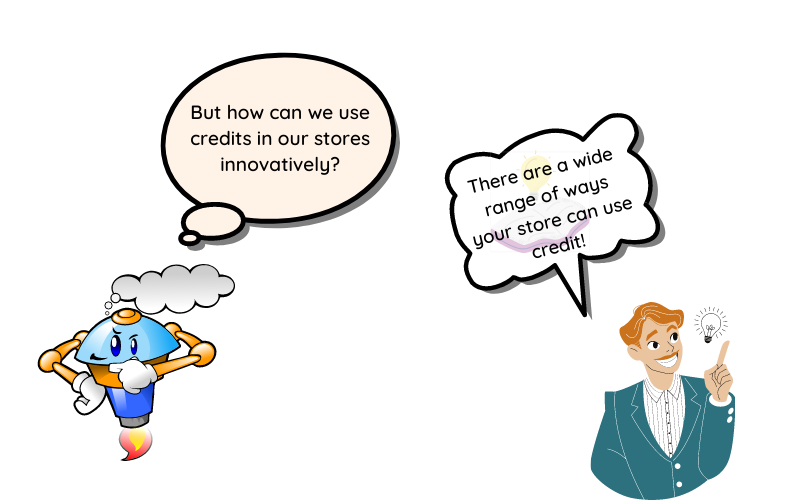General Resources
Step by Step Instructions to Reduce Sales Return and Sell More With Store Credit
- By harshmaur
- No Comments
12 Mar

A retail location may permit a customer to return a thing he purchased, if he isn’t satisfied with the thing. The retail location may give the customer his money back or invert the charges on his Visa, or it might keep the customer’s cash and offer store credit.
With store credit, the store opens a record with a positive point for the customer, so he can apply this point toward the expense of another buy.
To imply store credits for customers in your retail, you will need an ideal POS System like BooksPOS.
Store credit has the ability to do many things. It’s something more useful than another retail payment choice for its customers — it can help support maintenance and motivate brand devotion. You can expand spending and develop your store’s income by utilizing store credit purposely and in more creative manners. That is the reason the best retailers offer store credit in an assortment of structures — they’ve seen the advantages and multiplied down.
How about we see the ways you might use store credit to help assemble your business?
Table of Contents
What is Store Credit?
To start with, we should venture back and take a glance at what precisely we mean when we say “store credit.”

Store credit is a worth that you offer customers toward any buy they make with your business. This credit normally isn’t adaptable to different stores or brands. Moreover, it’s not the same as a deal or a rebate in that worth credit. This credit applies to one specific client and mostly doesn’t lapse the manner in which brief deals or advancements do.
As a storekeeper, you may offer this credit to your clients toward any buy they make. This credit score framework causes clients to outline the current offset with its set of experiences and the accessible gift voucher balance. One specific customer can claim their particular credit score in the store. It normally doesn’t end the manner in which transitory deals or advancements do.
It is highly unlikely to move the credit to other online stores, and its framework is not quite the same as a markdown or deal in that store credit. Furthermore, customers can apply their gift voucher equilibrium to get their credit in the store’s account.
Policy Terms
A retail location may offer a money discount for specific returns and just permit a store credit for other people. At the point when a store sets up a merchandise exchange, it incorporates conditions.
For example, bringing back the first box and covering that the item was sold in, bringing back the receipt and returning the item inside a specific time span, like seven days. The customer may need to fulfill the entire states of the merchandise exchange to get a money discount.
Displaying the Policy
State law may require a retailer to show a banner that clarifies the store credit strategy where customers can see it, although it mostly doesn’t compel the retail location to offer credit in their stores on all profits.
State law may give the unsatisfied customers certain rights when the retailer doesn’t put this banner up.
For example, the option to get a money discount for an item inside seven days if the thing is as yet in its particular condition.
Store Credit Account
At the point when the customers get back to make another buy, the credit in the store may not match the new bill precisely. On the off chance that the new buy surpasses the credit of the customer in the store, the customer actually needs to pay the excess part of the bill.
However, if the customer has remaining credit in their store’s account, they can use it to make a future buy. Store credit works likewise with a store gift voucher. It may end following quite a long while, contingent upon the time frame that state law sets up.
Damaged Products
State law may allow the customer extra rights if the retail location sold their customer a scratched, broken, or any non-practical item. State law may not permit a retail location to possibly offer store credit if the item is broken since the purchase or when the retail location sold it. This is because the trader makes a verifiable guarantee that the item will fill its promoted need. This standard may not matter if the shipper unmistakably named a messed up item available to be purchased in as-is condition.
Regular Types of Store Credit

There are four principal ways retailers use credit in the store everywhere in the world:
- Returns and trades: When clients return or trade stock, the credit score in the store is frequently offered notwithstanding or instead of a full discount.
- Store charge cards, financing, and loan: Any time a retailer stretches out credit and permits clients to pay sometime soon, or gradually, they’re giving them a credit score in their store’s account.
- Gift cards: When a client purchases a gift voucher, they basically are buying a store credit to provide for another person. Gift vouchers likewise are resorted to hold store credit from returns or devotion rewards.
- Loyalty rewards: One of the most well-known prizes clients gain through loyalty programs is a store credit for a future buy.
The worth of providing customers with store credit?
There’s an explanation for the world’s best retailers to all using credit scores in their store — for a couple of reasons, really. Most importantly, store credit offers you adaptability and an additional gear to help move customer’s spending and reliability.
How about we take a gander at the top advantages of offering credit scores in the store:

Benefits For Retailers
Boost loyalty and customer retention
Store credit can help retailers in gaining customer maintenance and everlasting faithfulness.
All in all, credit scores offer customers an extra engagement option (on top of extraordinary items and a customer experience) to return to your shop as opposed to looking somewhere else. As one aspect of a vigorous customer loyalty program, credit in stores gives you one more instrument to grandstand to customers how their rehashed business affects you.
The very much planned store credit framework gives customers an extra inspiration to return to the store. That is the reason retailers effectively use POS Credit Store augmentation to support customer maintenance and devotion.
Motivate customers to spend more
Use of credit in stores to compel customers to go through more cash may appear to be outlandish — however it works.
For somebody, adding store credit usefulness to urge customers to go through additional cash appears to be irrational. Nonetheless, it functions admirably. At the point when stores propose a sensible merchandise exchange, the purchasers appreciate the plan to go through more cash.
GE Capital once ran an examination on retailer-marked charge cards (a kind of store credit) and discovered they prompted more frequent visits to that retailer, with a 29% expansion in-store visits. Customers who shop using gift cards regularly spend far over their store credit, as well as prompting higher deals.
Customers likewise hold their thoughts about spending more when stores offer a reasonable return policy. Moreover, if you use store credit flexible returns, more you’re assisting customers with feeling good going through with you.
Along these lines, using the store credit for permitting more adaptable returns, you let your customers feel great being with you.
Decrease losing revenue to returns
Returns and trades are unquestionably not the most charming occasions for storekeepers. They need to furnish customers with a positive encounter and to be adaptable yet lost income.
Store credit will assist you with trying not to lose income to returns and transform the exchanges into trades, all things considered, making e-business more customers agreeable.
Returns and trades can place retailers high and dry. You need to be adaptable and furnish customers with a decent, fulfilling experience, however returns mean lost income, period.
Offering store credit is one way you can avoid losing revenue to return also, help transform those exchanges into trades, all things considered.
Store credit empowers you to grow your merchandise exchange to a more drawn out time period or acknowledge returns without a receipt — making your arrangement customer agreeable. This additionally guarantees more cash stays inside the business, helping facilitate the weight of profits on your primary concern.
Benefits For Customers
Buy Credit
Your customers get an opportunity to buy Store Credits directly from your POS System. Purchasing the credit, re-energizing it, and making buys! What’s more?
Offer Store Credit with companions
With the shrewd Credit expansion for stores, your customers are capable not just use their credit points to pay for products and outline all exchanges any time later yet besides share acknowledge balance for companions. To make this, customers determine the beneficiary’s email and the credit sum.
In the wake of accepting the credit, companions may spend their equilibrium on any items in your store. Looks valuable for all gatherings, right?
Get significant measurements
Reports of Store Credit are planned to decide how viable your credit program is. The measurable representation of credit execution offers customers the chance to get brisk and significant bits of knowledge.
Innovative Ways to Use Store Credit to Grow Customer Retention
Since you realize the advantages store credit can give, you need to investigate how to approach actualizing it.
Finding creative approaches to offer store credit can set your business a step above contenders and move a lot further in assisting with boosting customer maintenance and spending.

There are a wide range of ways your store can use credit, however, here are the three most significant ones: to incorporate social duty into your business, to boost customer references, and to increase your merchandise exchange.
Use Store Credit to be Charitable
As showed by Forbes, over 66% of all consumers — and 73% of twenty to thirty-year-olds — will go through additional and socially dependable retailers.
A brand’s social obligation ability has come in a whole new shape and sizes. Yet, they all make them likely in a manner: a monetary responsibility. That can be difficult for more modest retailers to pull off.
By utilizing store credit rather than money as your beneficent commitment, your store can have to a greater extent and effect without straightforwardly affecting income.
For instance, you can give gift vouchers or other store credit to noble cause or causes you and your customer care about. Or then again, you can offer store credit to individuals, representatives, or recipients of not-for-profits.
Giving store credit or gift vouchers is more practical for some more modest retailers than giving money — yet it’s as yet imperative to consider the expanded expenses.
Boost Referrals with Store Credit
A lot of retailers offer steadfastness programs, yet the most brilliant make it a stride further: they offer a reference program for purchasers, as well.
Consider the new achievement of direct-to-buyer (D2C) brands like Dollar Shave Club and Warby Parker. Those organizations have seen a huge load of development by disturbing conventional ventures. They additionally all offer very much broadcasted referral programs to help spread word of mouth.
Your store can do likewise by boosting that informal exchange and offering store credit in return for any references that transform into new clients.
Extend Your Return Policy and Add Flexibility
In the U.S., customers return a normal of 8% of all retail deals. That amounts to about $260 billion annually. At the point when we talk about the impact of a decent merchandise exchange on deals, we’re typically centered on internet business brands — however, the equivalent applies to physical retailers.
An investigation at the University of Texas, Dallas tracked down that a tolerant merchandise exchange led to higher sales across the over 11,000 retailers analyzed.
As referenced above, store credit (ordinarily as a gift card) is one manner in which you can add tolerance and adaptability to your merchandise exchange and profit by those expanded deals. Offering store credit for returns implies you can permit clients a more drawn out return time period and be more adaptable about receipts and labels required — all while guaranteeing you don’t miss out on income.
With The Of Use Store Credit, Reduce Sales Return, and Boost Customer Retention

Store credit is much something other than another path for customers to pay. It’s an apparatus you can use to help develop customer maintenance and increment deals. Finding creative better approaches to do that can carry immense advantages to your store.
The business estimation of the Store Credit framework is self-evident. This is the situation when a keen and incredible expansion similarly benefits storekeepers and their customers.
- As a storekeeper, you can add or deduct credits, see exchange history, set minutes/max credits, send warning messages to customers, and so forth
- It enables your customers to oversee credits, screen the equilibrium and the historical backdrop of exchanges, share the credits with others, and the sky is the limit from there.
How might you use store credit to help your store’s primary concern?
Store Credit in POS
BooksPOS permits you to oversee store credit. This implies you can deal with credits and returns and leave the cash on the client record to be utilized to pay for another deal now, or later.
FAQs
How do I receive store credit?
We will offer you credit in the full amount of your purchase, without deducting a single charge. We will store your credit in your account so you can use them for your next purchase. If you make a new buy, you can use your credit in the store instead of paying for it.
What if my credit is low than my purchase amount?
No worries! We will deduct your store credit for the total of your purchase and charge you the remaining balance. For instance, your total order is for $100 and your credit is limited to $80. We will simply deduct $50 from your credit score and charge you with the rest $20 to complete the purchase.
Can I use a particular amount from my credit score?
Yes, ofcourse, you can. For illustration, let’s say you are purchasing an item worth $29 and your credit score stands for $50. At checkout, the POS System will automatically deduct your credit score, leaving a balance of $21 ($50-$29) in your credit account.
We hope this blog helped you understand how store credit can influence your business. If you still have any queries, you can share it with us in the comment section below. We are always available to you.








